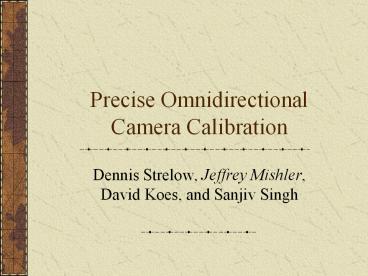Precise Omnidirectional Camera Calibration - PowerPoint PPT Presentation
1 / 20
Title:
Precise Omnidirectional Camera Calibration
Description:
Precise Omnidirectional Camera Calibration ... Projection model handles noncentral omnidirectional cameras ... viewpoint cameras. Omnidirectional projections ... – PowerPoint PPT presentation
Number of Views:118
Avg rating:3.0/5.0
Title: Precise Omnidirectional Camera Calibration
1
Precise Omnidirectional Camera Calibration
- Dennis Strelow, Jeffrey Mishler, David Koes, and
Sanjiv Singh
2
Overview (1)
- Projection model for omnidirectional cameras that
accounts for the full rotation and translation
between camera and mirror - Projection model handles noncentral
omnidirectional cameras - Calibration algorithm determines relative
position from one omnidirectional image of known
3D targets
3
Overview (2)
- One image sufficient for accurate calibration of
transformation - Full calibration allows shape-from-motion and
epipolar matching even if camera-mirror
misalignment is severe - Full model improves shape-from-motion and
epipolar geometry results even if the camera and
mirror are closely aligned
4
Omnidirectional cameras
5
Omnidirectional projections (1)
- The mirror point m determines the projection
6
Omnidirectional projections (2)
- Finding the mirror point is
- one-dimensional (z only) if the mirror and camera
are assumed aligned - closed form for aligned single viewpoint cameras
7
Omnidirectional projections (3)
- If the camera and mirror are not aligned, then
two constraints determine m
8
Equiangular Cameras (1)
9
Equiangular cameras (2)
- Relative rotation, translation between axes
distorts projections
10
Calibration (1)
11
Calibration (2)
- Least squares error to be minimized
- Known 2D projections xi, 3D points pi
- Unknown Camera position Rc, tc mirror-to-camera
transformation (implicit in ?)
12
Experiments (1)
- Basic questions about calibration
- 1. Does the calibration produce the correct
mirror-to-camera transformation? - 2. Is the model correct, e.g., is it possible to
perform SFM with misaligned a mirror? - 3. Is the full model worthwhile if the mirror is
nearly aligned?
13
Experiments (2)
- Three lab sequences
- Mirror and camera axes
- 1. Closely aligned
- 2. Moderate misalignment
- 3. Severe misalignment
14
Experiments (3)
15
Experiments (4)
- Performed shape-from-motion on each sequence
using each of three calibrations - A. Calibrate nothing
- B. Calibrate mirror-camera distance
- C. Calibrate rotation and translation
- Calibration B is interesting because computing
the projection in this case is a one-dimensional
problem
16
Experiments (5) residuals
- Difference between observed target image location
and reprojected location (pixels)
17
Experiments (6) values
- Sequences differ mainly in tx
- Standard deviations are small
18
Experiments (7) apex reproj.
- Difference between observed screw center and
reprojected mirror apex
19
Experiments (8) SFM
- Shape-from-motion average reprojection errors
(pixels) and depth errors (cm)
20
Experiments (9) epipolar error
- Average distance in pixels from epipolar line to
correct match































